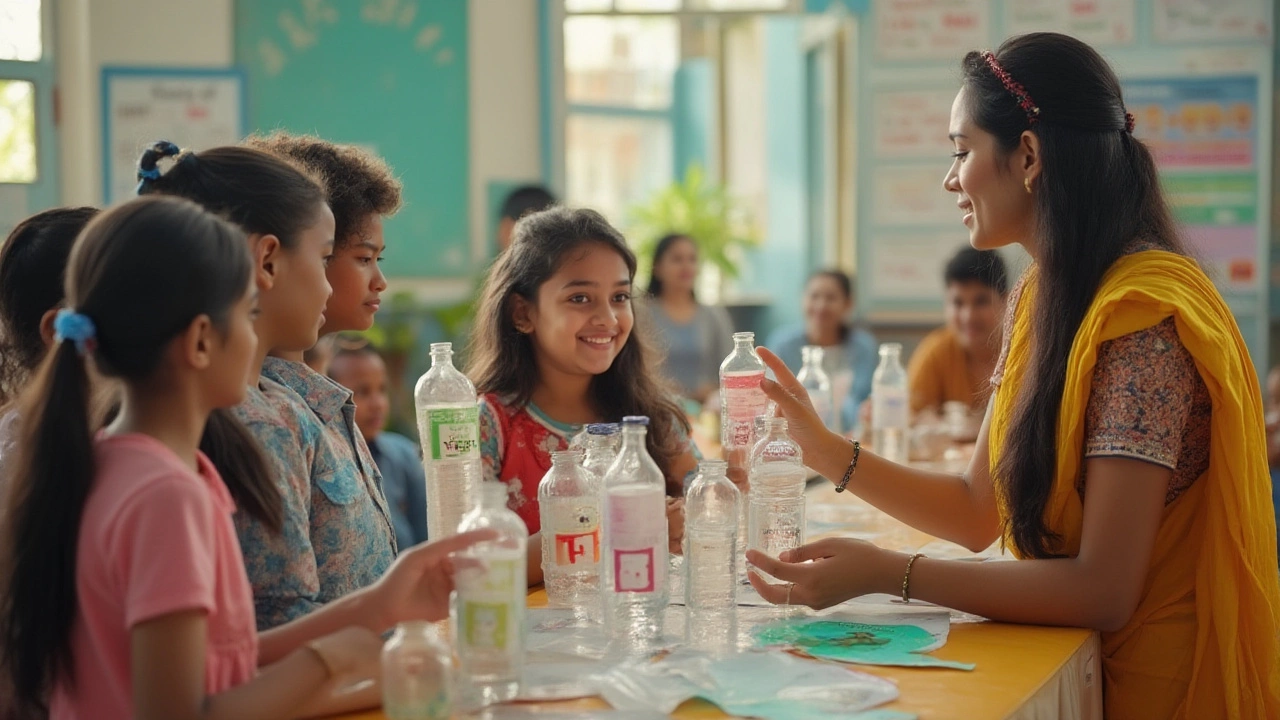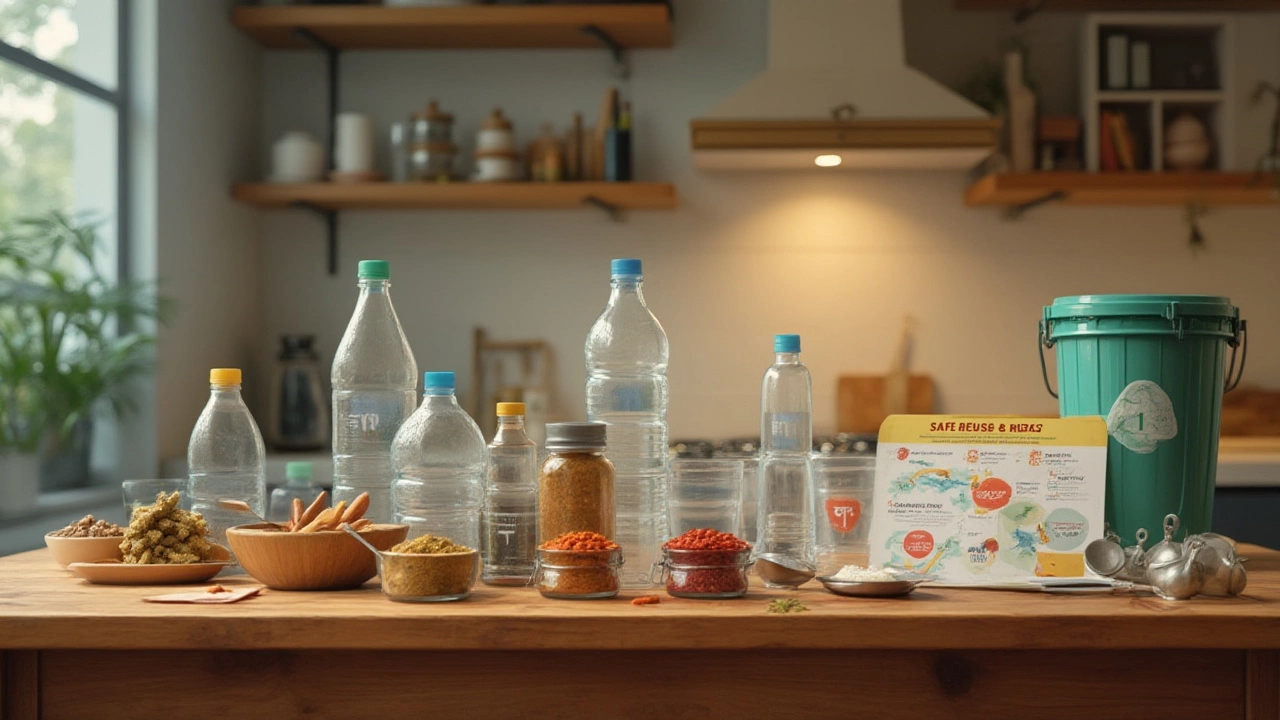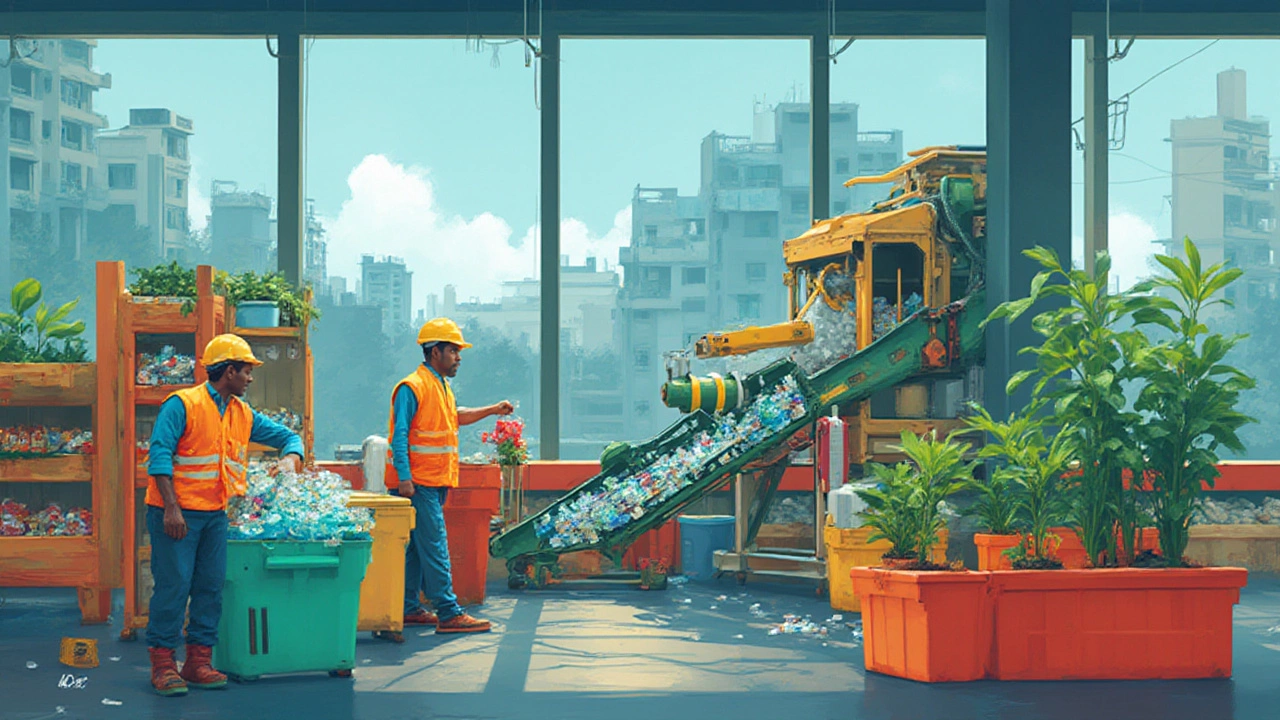 Jul, 5 2025
Jul, 5 2025
If you’ve ever looked at the bottom of a water bottle, you’ve seen it—a little triangle with a number inside. Maybe you’ve wondered why that number matters or shrugged and tossed the bottle in the bin. That number isn’t random; it’s a code that reveals a lot about your plastic. The most common? That solitary “1.” What does the number 1 on plastic actually mean? Turns out, more than you think.
What Is the Number 1 on Plastic: PET Unraveled
Flip over almost any single-use water bottle and you’ll see it: plastic number 1 stamped in a chasing arrows triangle. Here’s the scoop—number 1 stands for Polyethylene Terephthalate, or PET (sometimes PETE). Why do companies use it everywhere from bottles to salad containers? PET is lightweight, clear, and tough enough to hold liquids under pressure without cracking. In fact, it’s the most popular plastic worldwide for single-use bottles.
Let’s get specific for a sec. PET was first patented in the 1940s by British chemists who were looking for a better synthetic fiber. After it took off in clothing as “polyester,” it found a second life in packaging. By the late '70s, plastic bottles made with PET became the norm for soft drinks. According to The International Bottled Water Association, over 60% of bottled water containers globally are PET.
You can spot PET plastics by their clarity and smooth feel. Flip over your soda bottle, peanut butter jar, or salad dressing container—you’ll see the “1.” PET is used in:
- Water and soda bottles
- Salad and berry containers
- Peanut butter jars
- Microwavable food trays (rarely)
- Certain cosmetic bottles
What makes PET special? For one, it’s an excellent moisture barrier, which keeps fizzy drinks fizzy. Since it’s light, it cuts shipping costs and emissions compared to glass. Plus, recycling PET is relatively straightforward (well, sort of—more below!).
But the triangle with the 1 isn’t a recycling logo—it’s an identification code. The “number 1” tells recycling facilities what kind of plastic they’re dealing with—it doesn’t guarantee your bottle will get recycled. This code system started in 1988, when the plastics industry agreed to a universal set of numbers, 1-7, to help sorting at recycling plants.
An interesting thing about PET: Nearly all new beverage bottles have at least some recycled PET in them now. Check the fine print on a label; you’ll often see “made with up to 30% recycled PET.” This helps clamp down on the mountain of new plastic being churned out every year.
But PET is not perfect. On one hand, it’s great for packaging and recycling. On the other, if you reuse it too much or expose it to heat, things can get sketchy (think chemicals leaching—more on that soon). So, is the number 1 plastic safe? Keep reading.
| PET Plastic Facts | Details |
|---|---|
| Introduced Year | 1940s (as fiber), 1970s (for bottles) |
| Common Uses | Bottles, food packaging |
| Recycled Into | New bottles, clothing (fleece), carpets |
| Percentage of Water Bottles Using PET | Over 60% |
| Safe for Hot Reuse? | No, not recommended |

Is Plastic Number 1 Safe? Health and Environmental Concerns
If you’re anything like me, you grab a water bottle on your way out, refill it at work, and sometimes leave it in your hot car for hours. But is number 1 plastic safe to reuse? Scientists have asked the same thing. PET plastic is considered safe for its intended use—typically single-use. The FDA has approved PET for contact with food and beverages as long as it’s used correctly. But repeatedly refilling it, exposing it to heat, or washing it with harsh detergents? That’s when things get dicey.
The main concern: chemical leaching. PET itself doesn’t contain Bisphenol A (BPA), which is what caused the outcry about reusable water bottles a decade ago. But, under high heat or repeated wear, PET can start releasing small amounts of antimony, a catalyst used in its manufacturing. The World Health Organization says drinking water in PET bottles generally has antimony levels well below the safety threshold. But studies by the University of Heidelberg showed that heating PET (sometimes even leaving it on a sunny dashboard) can slightly raise those levels.
"While the levels detected are not believed to pose immediate health risks, it’s advisable not to reuse or heat PET bottles frequently," says Dr. William Shotyk, Environmental Science Professor at the University of Alberta.
What about the environment? PET is one of the easiest plastics to recycle, and in theory, it can be recycled over and over. But here’s the ugly truth—only about 29% of PET bottles in the U.S. actually make it to recycling. The rest? They end up in landfills, oceans, parks, and sometimes—like the bottle Rex tried to bury in the backyard—in your garden. Plastic number 1 can take up to 450 years to break down, all the while fragmenting into microplastics that contaminate soil and water. No joke: recent studies found microplastics in both bottled and tap water across the globe.
But let’s make this practical. Here’s how to use PET safely:
- Don’t reuse single-use PET bottles for long. They’re not designed to withstand repeated squeezing, washing, or heating.
- Keep PET bottles away from extreme temperatures. Don’t leave them in hot cars or dishwashers.
- If your bottle looks scratched or cloudy, chuck it in the recycling.
- For reusable water bottles, look for “BPA-free” options made of stainless steel or special plastics like Tritan.
Want an easy way to spot safe plastics? PET (number 1) and HDPE (number 2) are generally considered the safest for food storage. Avoid microwaving or reusing plastics numbered 3 (PVC), 6 (PS), and 7 (Other) unless you know for sure they’re food-safe. You can always check the chart below for a quick cheat sheet.
| Plastic Code | Name | Common Use | Food Safe? |
|---|---|---|---|
| 1 | PET (Polyethylene Terephthalate) | Bottles, Food Containers | Single use only |
| 2 | HDPE (High Density Polyethylene) | Milk Jugs | Safer |
| 3 | PVC (Polyvinyl Chloride) | Cling Wrap | Avoid |
| 6 | PS (Polystyrene) | Foam Cups | Avoid |
| 7 | Other | Various | Depends, usually avoid |
One weird but true tidbit—the recycling market for PET is bigger than any other plastic. Used PET bottles get turned into everything from t-shirts to sneakers. My girlfriend once bought a fleece jacket made from 20 recycled PET bottles. It actually kept her warmer than my old college hoodie.

Recycling Plastic Number 1: Myths, Tips, and New Uses
Pretty much every city recycling program begs for your plastic bottles, especially ones marked with a “1.” But why do so many bottles still end up in the trash? The answer: confusion, lazy habits, and a little bit of wishful thinking.
People assume that the chasing arrows triangle means “recyclable anywhere, anytime.” Reality check: Not every city can process every kind of PET plastic. For example, narrow-neck bottles (water or soda) are almost always accepted. But clamshell containers from deli salads? Some recycling facilities won’t take those. Why? They melt at a different temperature and can actually gum up machines. Check your city’s guidelines, or bookmark your recycling center’s website. It makes a difference.
Here’s a quick hack: If in doubt, recycle bottles, but compost containers or throw them out if your local service doesn’t take them. Always rinse bottles before recycling—leftover soda or peanut butter can ruin a whole batch of otherwise good recyclables at the sorting plant. Lids, by the way, should usually be put back on the bottle before recycling.
Ever wonder where recycled PET goes? There’s a whole second life most of us never see. After being shredded and melted, PET often turns into:
- New bottles for water, soda, or household cleaners
- Polyester fibers for clothing, carpets, or insulation
- Strapping for shipping boxes
- Tennis ball felt (who knew?)
- Even car parts or 3D printer filament
The real champion here is the closed-loop bottle-to-bottle recycling process. Brands like Coca-Cola and Nestlé have committed to using at least 50% recycled PET in some bottles by 2030. But the big results only happen when everyone does their part to recycle PET properly.
What else can you do, besides tossing that bottle in the blue bin?
- Cut down on single-use plastics by switching to reusable bottles when you can.
- Look for packaging labeled “made from recycled PET.”
- Support brands going the extra mile to reduce virgin plastic production.
- Spread the word—teach friends and family what the plastic numbers actually mean.
Here’s a fun pet tip from life with Rex: if your dog digs up an empty bottle and you spot the number 1, just toss it in the recycle bin instead of the trash. Every small choice stacks up—less trash in landfills, more material for new products, and a little less plastic ending up where it shouldn’t. Small, sure, but it adds up, bottle after bottle.
Turns out, that little “1” on your bottle is a whole world in itself—one part science, one part habit, and a whole lot of impact.